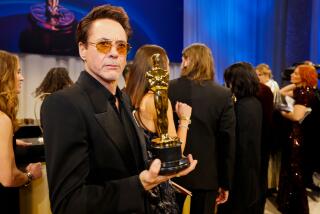AMERICA’S CUP UPDATE : NOTEBOOK : Have a Ball--But Don’t Tax the Committee’s Finances
- Share via
SAN DIEGO — The America’s Cup XXVIII Ball on May 7 is being promoted as “the biggest social event on the America’s Cup ’92 calendar.”
A similar event for the International America’s Cup Class World Championships last May, staged by the America’s Cup Organizing Committee, sparked considerable controversy for a lavish display of excess in an event with serious financial problems, although the ball itself lost only a few thousand dollars.
This time the event is being organized by a volunteer (read unpaid) committee of 90 based at the San Diego Yacht Club, headed by Jane Fetter and including representatives from the ACOC, the Challenger of Record Committee and all syndicates that have competed.
All 90 are women. They do not intend to give any men a chance to muck it up.
The ball will be at the San Diego Convention Center. Peter Duchin’s orchestra will play, as it did last May.
The ball is open to any members of the public who have $175 each and can rent a black-tie outfit for the night. That’s a bargain. The one last May was $225. Reservations: (619) 222-1103.
There also are plans for a “Poor Man’s Ball” for $17.50 at the America’s Cup International Centre. Now all the yachting crowd needs is something for the unemployed at $1.75. Come as you are.
For all the difficulty the sailors have had trying to outguess the wind off Point Loma, Dennis Conner says it’s better than Newport, R.I., where the Cup defenses were held until Australia II took it away in 1983.
“San Diego in general is easier to predict,” Conner said. “The tide doesn’t change like it does in Newport. The tide just pushes the current in and out in the opening of San Diego Bay. You can measure it before the start. At Newport, with the inlet into Narragansett Bay, it’s a big body of water.
“As far as the wind conditions here, generally the sea breeze and the Catalina Eddy are there to cause an on-shore flow, whether it’s from the 230 wind direction or the 300 sea breeze coordinate. You can count on an on-shore breeze, where in Newport they have more system breezes.
“Particularly in the beginning of the season and the end of a season when you have a front come through, the flow is increasingly from the south as the fronts approach, and then it would switch to the northwest, and the first day, if the northwester was strong, it would gradually fade out and go back around to the southwest corner. It’s not as easy to forecast.
“Here you can count on 7 to 11 knots of wind from the west or southwest quadrants.”
As anyone can see, there’s more to sailing than sailing.
The George Nicholson who rode as Stars & Stripes’ 17th crewman one day this week is the son of England’s Charles E. Nicholson--an historic figure in the Cup.
The elder Nicholson designed Shamrock IV and V for Sir Thomas Lipton and then Endeavour for T.O.M. Sopwith in 1934. In 1920 Shamrock IV lost to Resolute, 3-2, and in ’34 Endeavour--generally regarded as a much faster boat--lost to Mike Vanderbilt’s Rainbow, 4-2, after winning the first two races. No two challengers ever came closer to winning the Cup until Australia II took it away in ’83.
George Nicholson, a boat builder, is associated with Conner and his newest sponsor, Mexican media mogul Emilio Azcarraga of Televisa in the upscale North Cove Marina project in New York City, at the foot of the financial district, where Conner’s Whitbread Round-the-World Race effort will be based.
Azcarraga--target of the “Thanks, Emilio” sign on Stars & Stripes’ boom vang, in front of the on-board TV camera--also was the publisher of the short-lived National sports daily newspaper.


